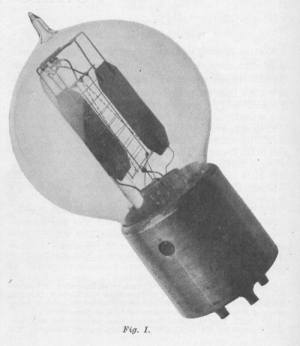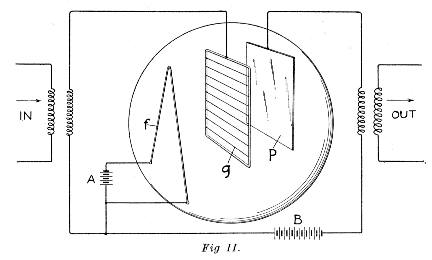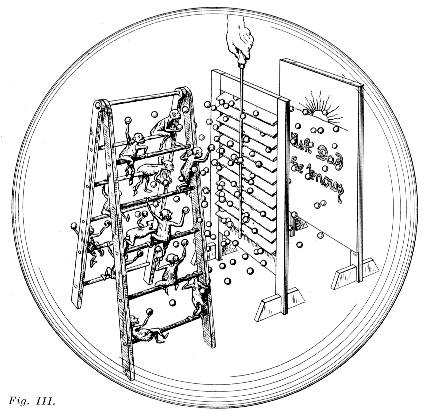
Telephone Collectors International
How the Repeater Repeats
Last update May 14, 2015
 | Telephone Collectors InternationalHow the Repeater Repeats | First Posted Apr 1, 2000 Last update May 14, 2015 |
Our Tribute to the Engineering and Science of the Bell System
April 1, 2000
When "Western Electric" is mentioned, telephone collectors immediately think of telephones. To the audiophile, however, vacuum tubes such as the legendary 300B come to mind. Western Electric's involvement with the Vacuum Tube goes back to 1912 when AT&T first experimented with the de Forest Audion to determine whether it could be used as a telephone repeater. Although the Audion did not have the stability or long life necessary for commercial telephone service, the research branch of Western Electric under the direction of Dr. Harold D. Arnold eventually developed a vacuum tube that would meet the demands of the telephone industry. The first transcontinental telephone line between New York and San Francisco, which opened for service on January 25, 1915, owed its success as much to the perfection of the vacuum tube repeater as it did to the heroic efforts of those who actually built the line that spanned the country.
Western Electric's perfection of the vacuum tube continued with its development of the public address and theater sound systems that are still sought after by audiophiles today. Even now, with the common belief that solid state electronics have banished the vacuum tube forever, the legendary Western Electric audio tubes are still being made to their original specifications for a small but faithful market which refuses to settle for anything less.
What did Western Electric have to say about that product that revolutionized telephony? This year, our April Fools offering takes the reader back to 1917 when the vacuum tube was considered "bleeding edge" technology. Certainly, many scholarly treatises were written about the vacuum tube but the March issue of Western Electric News decided to take a more light-hearted approach. It is my hope that you find it as much fun to read as I did.
Paul Wills - Telephone Collectors International
By I. Manutt
REMEMBER the little girl in Peter Pan who came close to the footlights and appealed earnestly to the audience like this:
"You do believe in fairies, don't you?"
You probably smiled; maybe you had a couple of kiddies of your own, and the smile was for their benefit. But deep down in your heart did you feel like smiling, or were you sadly wishing you could believe in such foolishness?
The inevitable butcher, baker and candlestick maker, to say nothing of the landlord, all act to force upon us the unwelcome belief that only hard work and real money will bring us the pleasures our ancestors are said to have sometimes enjoyed as a reward for kindnesses to fairies in disguise. Friend wife's new lid, though unsubstantial, must be paid for with good hard iron men out of the weekly envelope, which always seems just too thin for all our needs. But all of us are not so constituted; to a few is granted, so 'tis said, the ability to hold communion with the "Land of Dreams."
For hundreds of years poets have sung of Faerie Queenes, Golden Fleece and other confidence games. It got so bad at one time that to protect the people the police made all poets take out a license and to this day you hear a raw piece of work excused on the ground of poetic license. Another class of humans who have dealt in fairy tales are prophets, but they have generally died out in these days of strict sanitation laws.
A new cult has, however, sprung up during the nineteenth century which far exceeds the prophets and poets of the past in the unbelievable kind of stories they tell of things no one has ever seen while awake and sober. This curious sect is generally known as the "highbrow bunch," and they must be treated in accordance with certain traditions which have grown even in the last hundred years or so. When approaching them it is necessary to walk softly with a sidling motion so as not to disturb their meditations; also never mention money even in ordinary conversation as they are very sensitive on this matter and cannot bear to hear anything about expense. They also require a special atmosphere in which to work and certain very special rooms have been constructed in our West Street building in which these highbrows function. These rooms have been called cloisters.
The highbrow is difficult of approach but every one knows you can get nothing definite out of a poet; they are almost as vague as salesmen. On the other hand our friends of the elevated domes would satisfy even the income tax collector. They certainly can tell the weirdest fairy tales you ever heard, all accompanied by a brain- storming mass of figures which leaves you gasping with admiration. Baron Munchausen could tell stories, and the Senator from Sorghum Center can explain why he didn't extract more nourishment from the pork barrel for his home town, but neither of these members of the Ananias Club has anything on our cloister boys.
Their explanation of the problem, "Why does a hen cross the road?" is so full of square roots, differential increments and other mathematical signs including pi, that you would be hopelessly exhausted and anyway maybe you don't believe in signs.
Well, here is their answer to "How does a repeater repeat?" In the first place they refer you way back to the grandfather of all highbrows, Clerk Maxwell, who could make the calculus do ground and lofty tumbling and eat out of his hand. In fact from all we know of this gentleman we believe he was probably the only man that ever lived who could answer all the questions the comptroller asks before the books are closed. Well, our highbrows tell us that he found it convenient to demonstrate some of his theories by the fairy method, only he called them "daemons." They didn't have any comptroller where he worked or he never would have gotten away with it. By bringing in a daemon, however, he proved that it might be possible to heat a small quantity of gas or air from a larger amount at a lower temperature In other words, you could get hot air from cold air if you had a daemon to assist you.

You all remember what you learned at school about matter being made up of molecules and molecules being made of atoms beyond which matter is indivisible. That is, with a meat axe, like Jack Lyng talks so much about, you can divide a substance into small pieces like hash; and with a microscope and hair-splitting equipment like hat of another prominent engineer you can divide a substance into pieces smaller than the naked eye can distinguish; after that by means of chemicals you can separate molecules from each other although you can't see them even with a microscope; then with more chemicals you can separate the atoms from each other, but beyond this no treatment has any effect; at least that's what we learned at school and that effectually proves that there are no such things as fairies or daemons. But now come our highbrows with another story. Mind you, you don't have to believe it. They say that atoms may be made to throw off particles like a small boy throwing gravel at the passing trolley car, only the kiddies do it voluntarily for the fun of the thing, whereas the atoms must have some provocation; for example, if they get good and hot they commence to throw gravel like a terrier pup at a woodchuck hole.
Now, all ordinary people know how to take such talk as this. It's just like Arabian Nights and Dr. Cook stuff about stones talking and mountains splitting open, or the beautiful stripes around the North Pole. Nevertheless one of our cloister experts will draw you a picture like Figure 2, to represent the interior of one of our repeater bulbs, shown in Figure 1, and says that "f" is a filament which is heated red hot by the electric current from battery "A," and "P" is a plate which is connected to the outgoing line. In the space between the filament and the plate is the piece of picket fence "g," which is connected to the incoming line, and this gridiron is what puts the fire in amplifier.

To make the matter clear as a fairy tale should be, look at Figure 3, where instead of a filament there is an iron stepladder on which you can see a lot of atoms, or daemons --it doesn't matter which you call them--and on the other side you side the plate as in Figure 2. Between these two is an ordinary window blind with slats which are all operated together by the usual center stick. Now, suppose a strong electric current is passed through the iron step ladder so that it heats up like the filament in Figure 2, then each little daemon gets as mad as a hen on a hot griddle and begins to throw pebbles at the window shutter. What's that! Where do they get the pebbles? Say, this is a fairy story and you must not ask foolish questions; besides the highbrows are stumped by this question. Lord Kelvin thought the atoms were made of these pebbles or corpuscles, and that these corpuscles were electricity itself, hence the name electrons. In other words, matter is made of electricity and electricity is imponderable; therefore, there is no matter, and if that is no matter we should worry.

If while the daemons are bombarding the shutter we should open the slats, enough pebbles would go through and strike the plate to make a noise like a hailstorm on a tin roof and the number that strike the plate would be in proportion to the amount the slats are opened. Therefore, if the slats are opened and closed in time with music it would be possible to play a tune on the plate, and if each electron carried a little bit of electricity with it, the effect would be like a current from the stepladder to the plate, and this current would pulsate, increasing when the slats are opened and decreasing when they are closed. This is just what happens in the repeater bulb shown in Figure 2. The filament is heated red hot by the current from battery "A," and at this temperature millions of corpuscles or electrons are thrown off. The electric current is not necessary to cause this; the same thing would happen if it were heated by a gas flame. These electrons are considered to carry charges of negative electricity itself. Here again we should worry, because the result is the same, no matter what anyone thinks; because a current actually does flow from the filament to the plate.
You all remember that unlike polarities of electricity attract each other while like polarities repel, and so if the gridiron is made negative to the filament the electrons will be repelled by it and very few will get through between the slats; in fact, if the slats are too close together no electrons at all will get through to the plate. The effect would be the same as though the slats in Figure 3 were entirely closed.
In an article on "How the Telephone Talks," in the May, 1912, issue of the NEWS, it was shown how the sound waves produced electrical pulsations in the line; and you have only to imagine these pulsations of current coming to the induction coil at the left side of Figure 2. These pulsations are, of course, very weak because of the long line over which they have traveled and the purpose of the repeater is to amplify or strengthen these pulsations.
Now, while it takes considerable power to open and close the slats of a window blind, especially if you painted them yourself last spring, the operation of the electric shutter is frictionless and even the weak impulses of speech transmitted over 500 miles of line are sufficient to give the desired results so that as each increase or decrease of current raises or lowers the negative potential of the grating "g," more or less electrons each with its infinitesimal charge of electricity get through from the red hot filament to the plate and give the exact same, but much stronger, impulses of current from the plate to the induction coil at the right side of the picture, and so out on the line for another 500 miles, the amount of additional pep put in the impulses depending on the strength of the battery "B."
Now you are probably wondering why this apparatus is put in a glass case. The reason is that the scheme will only work in a very good vacuum because a clear space is necessary for the electrons to travel in. You must remember that everything, even an invisible gas, is composed of atoms, so if there was air or any kind of gas in the space between the filament and the plate the electrons would bump the atoms of the gas while the daemons might put a good many across, the number would not be constant from minute to minute, depending on how successful they were in dodging the atoms and the result of this would be a jerky current which would entirely mask the telephonic pulsations. Therefore, in order to obtain the required accuracy of control of the rate at which the electrons strike the plate it is necessary to pull out of the space between the filament and the plate every loose atom that it is physically possible to get hold of.
This is so important that our highbrows have developed an extremely interesting method of inducing daemons themselves to call the game when the space is cleared, but that is another story to be told when you have recovered from this one.
It should be noted that the Bell System was never known to abandon a good concept. Long after J. Bardeen, W. H. Brattain and W. Shockley of Bell Laboratories invented the transistor, which would become the successor to the vacuum tube, K. Thompson again harnessed the "daemon" as part of the UNIX operating system.